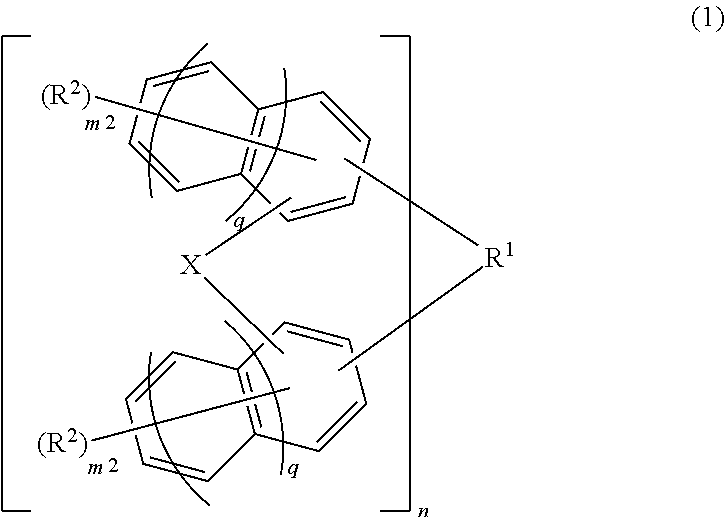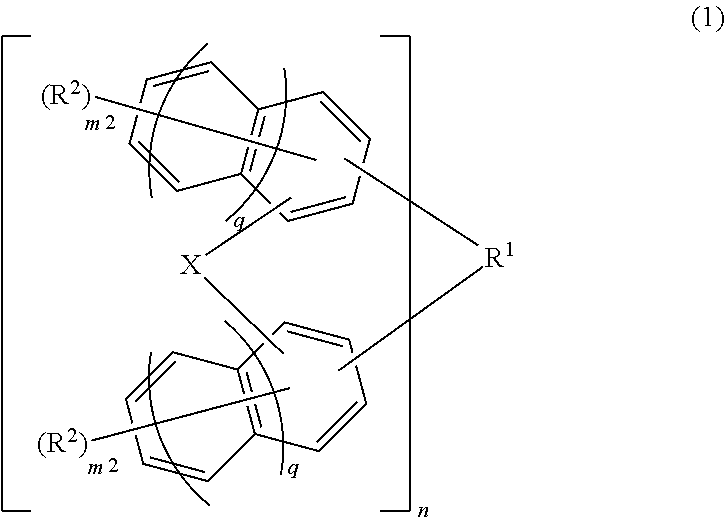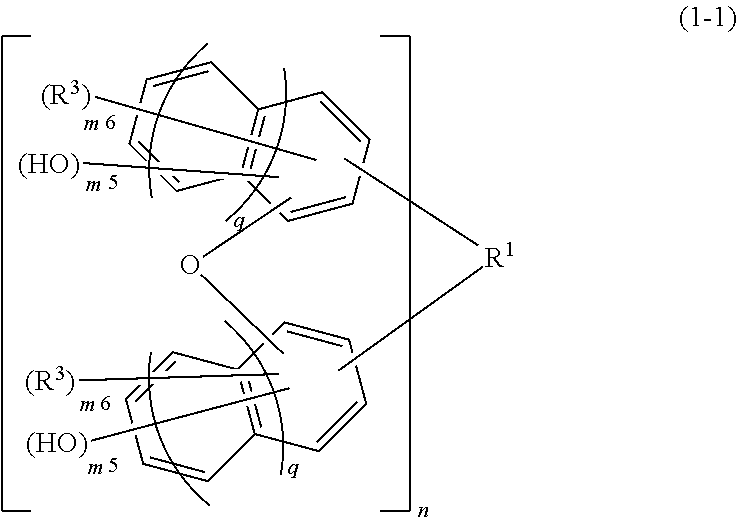Material for forming underlayer film for lithography, composition for forming underlayer film for lithography, underlayer film for lithography and production method thereof, and resist pattern forming method
- Summary
- Abstract
- Description
- Claims
- Application Information
AI Technical Summary
Benefits of technology
Problems solved by technology
Method used
Image
Examples
synthesis example 1
Synthesis of A-2 (Xanthene Compound)
[0190]In a container having an inner volume of 100 mL, equipped with a stirrer, a condenser and a burette, 3.5 g (20 mmol) of 2,6-naphthalenediol (reagent produced by Sigma-Aldrich Co. LLC.) and 2.3 g (20 mmol) of 4-iodobenzaldehyde (reagent produced by Tokyo Chemical Industry Co., Ltd.) were charged to 50 mL of γ-butyrolactone, and 0.3 g of p-toluenesulfonic acid was added thereto and stirred at 90° C. for 28 hours to perform a reaction, thereby providing a reaction liquid. Next, the reaction liquid was added to 500 g of pure water, and thereafter extracted by ethyl acetate and concentrated to provide a solution.
[0191]The resulting solution was subjected to separation by column chromatography and thereafter washing with chloroform, thereby providing 1.2 g of an objective compound (A-2) represented by the following formula (A-2).
[0192]The molecular weight of the resulting compound (A-2) was measured by the above method, and as a result, it was 516...
synthesis example 2
Synthesis of A-3 (Xanthene Compound)
[0199]In a container having an inner volume of 300 mL, equipped with a stirrer, a condenser and a burette, 7.0 g (40 mmol) of 2,6-naphthalenediol (reagent produced by Sigma-Aldrich Co. LLC.) and 5.6 g (20 mmol) of 5-iodovanillin (reagent produced by Tokyo Chemical Industry Co., Ltd.) were charged to 100 mL of γ-butyrolactone, and 0.5 g of p-toluenesulfonic acid was added thereto and stirred at 90° C. for 87 hours to perform a reaction, thereby providing a reaction liquid. Next, the reaction liquid was added to 1000 g of pure water, and thereafter extracted by ethyl acetate and concentrated to provide a solution.
[0200]The resulting solution was subjected to separation by column chromatography and thereafter washing with chloroform, thereby providing 2.0 g of an objective compound (A-3) represented by the following formula (A-3).
[0201]The molecular weight of the resulting compound (A-3) was measured by the above method, and as a result, it was 562.
[...
synthesis example 3
Synthesis of A-4 (Xanthene Compound)
[0208]In a container having an inner volume of 300 mL, equipped with a stirrer, a condenser and a burette, 7.0 g (40 mmol) of 2,6-naphthalenediol (reagent produced by Sigma-Aldrich Co. LLC.) and 4.5 g (20 mmol) of 5-iodo-2-furancarbaldehyde (reagent produced by Tokyo Chemical Industry Co., Ltd.) were charged to 100 mL of γ-butyrolactone, and 0.5 g of p-toluenesulfonic acid was added thereto and stirred at 90° C. for 24 hours to perform a reaction, thereby providing a reaction liquid. Next, the reaction liquid was added to 300 g of pure water, and thereafter extracted by ethyl acetate and concentrated to provide a solution.
[0209]The resulting solution was subjected to separation by column chromatography and thereafter washing with chloroform, thereby providing 2.5 g of an objective compound represented by the following formula (A-4).
[0210]The molecular weight of the resulting compound (A-4) was measured by the above method, and as a result, it was ...
PUM
| Property | Measurement | Unit |
|---|---|---|
| Area | aaaaa | aaaaa |
| Percent by mass | aaaaa | aaaaa |
| Percent by mass | aaaaa | aaaaa |
Abstract
Description
Claims
Application Information
 Login to View More
Login to View More - R&D
- Intellectual Property
- Life Sciences
- Materials
- Tech Scout
- Unparalleled Data Quality
- Higher Quality Content
- 60% Fewer Hallucinations
Browse by: Latest US Patents, China's latest patents, Technical Efficacy Thesaurus, Application Domain, Technology Topic, Popular Technical Reports.
© 2025 PatSnap. All rights reserved.Legal|Privacy policy|Modern Slavery Act Transparency Statement|Sitemap|About US| Contact US: help@patsnap.com



